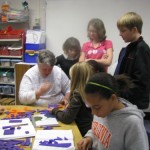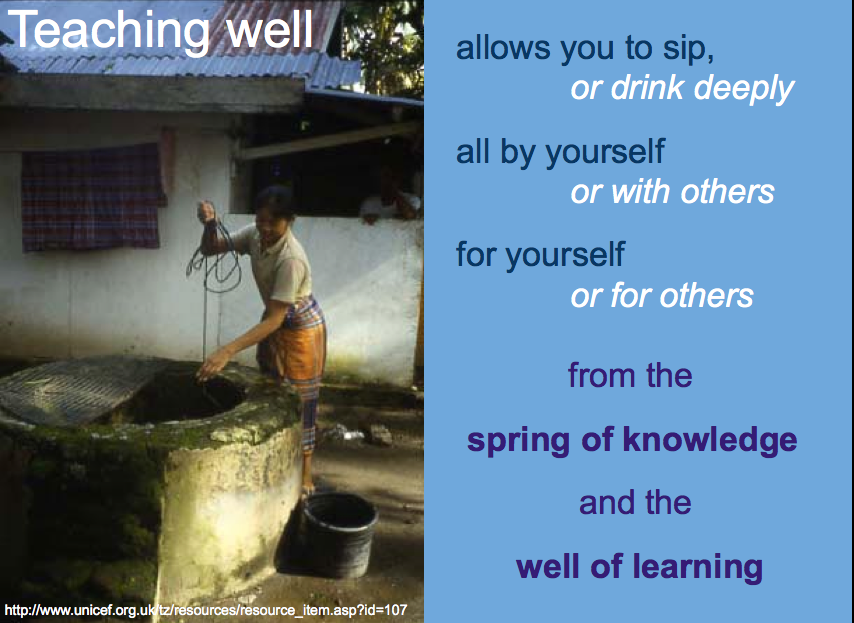I have had elementary students on wikispaces wikis for 3 years now. Over those 3 years, I have learned much about how to work the system to most thoroughly monitor everything the kids do–creating or making changes on pages, wiki-mailing one another and participating in discussions on other students’ pages. Recently several people in my county have asked for help, and so I tweeted out an older page I had created with some tips and tricks. There you can find a sample parent note and a permission form. Then, several folks in my PLN had comments or questions, so I thought I’d share what I do here.
First, for those of you new to wikis, (or unfamiliar with creating web pages or sites), let me give a fairly easy analogy. Each wiki is sort of like a folder–it is a central place where the owner or organizer can add different sections, much as a folder can hold only a few or many papers. The wiki is the container, and the pages created on that wiki are all inside of that container. (It’s like a folder that has papers inside.) What I typically do for my classes is create a group wiki, and give each kid their own separate wiki, and then connect those by listing each student on the main wiki. I then link that student name to that specific child’s wiki. So I nest the names of other folders within the main folder–or wikis connected to the main wiki. (See William’s wiki–he has clearly named the lists he has connected to in his navigation pane.) For example, under his cluster map is a list of the pages he has created, under that is a list of links (webpages) he likes, and then a list of school wikis and then other student wikis.
As you set up a wikispace for your class, think through how much you want to monitor, how you’ll use the space, and how you want your students to interact. The way you organize the space will DEFINITELY impact how the students support and talk to each other.
I typically set up the students with accounts on wikispaces, as it is extremely easy. Simply create a list of student names and accompanying passwords in a spreadsheet and upload it as you use the “usercreator” in the “manage wiki” area. I typically name the student logins with their first name and our school initials–paulacres would be mine, for example. Then I create the passwords all the same to begin with so that logging in for the first time is easy.
As I create the student accounts, I attach MY email to each one. I use a trick that works with a gmail account so that every single wikimail the kids send comes to MY email account. The trick is this: each student email is mygmailname+studentname@gmail.com. So, if I had a child named Drew, and my gmail account is whiteclass@gmail.com) the email I attach to the drewcres account is whiteclass+drewcres@gmail.com. (Google mail does not recognize whatever comes after the +symbol, but it still sends that mail to MY account.) Then, I set up my gmail account to be forwarded to my school account and also set up a rule to send all wikispaces messages to a folder on my computer so it does NOT stay in my school account OR my gmail account and they are all located in one folder that I can read with or without internet access. As they come in, it shows who is sending the wikimail AND who the wikimail is addressed to, so I have a clear record of who sends and receives the mail.
I spend some up front time creating each student wiki and setting up the main page for accessing each one (such as the Crozet 5th math page). Since I create it, I then have the ability to accept or deny other members of this wiki. I begin by inviting the named student to the wiki and making him or her an organizer so they can do the same, and they have the ability to change the appearance of their wiki.
At the top of the wiki is a tab called notify me. As the teacher, I want to be notified of ALL changes on the entire wiki, so I make sure I set it so that I get notified of ALL changes in both the discussion tab and on the pages, wiki-wide. Make sure you don’t select JUST the changes on the home page as you create each student wiki.
When I introduce wikis to the students and have them login the first time, I give them certain rules AND also have them change certain settings on their wiki.
First, we all go to the account settings together, and
1. they select the correct time zone,
2. change the setting about wikimail to “ONLY allow private messages from other members of wikis I belong to“
3. change email private messages to YES
4. change email monitored changes to YES.
With those settings, as the teacher, I get notified of every change made and every email written and sent.
Secondly, I tell them the following things:
1. This wiki is set up under the umbrella of you as a student at Crozet Elementary School so any rule in place here at school is in place with the wiki–appropriate behavior, language and courtesy. Using t he wiki or wikimail, you are a representative of Crozet School and you have to make sure anything you do will be okay with your parents, your teacher and the principal.
2. EVERY single email you send or receive comes into my email box, so know I have a record of every single thing you read and write. Make sure you are being an appropraite representative of Crozet Elementary school.
3. I show them the history tab (on the wiki I created to house the links to their wiki) so they clearly see every change I made and the time stamp. I tell them this is a feature in every wiki page, so they can never do anything without a record being kept. I explain it as a safety feature for them–so if someone claims they messed up their page, the history can show they did not.
4. I tell them they can never delete an email they send or receive. They are to archive EVERYTHING. Again, this is for THEIR safety, so that if they are accused of sending a nasty email, I can show the accuser they did not. (I remind them here I will also have copies in my mailbox.)
5. I also say that if I EVER find they have deleted an email, they will be off wikispaces immediately, (since I can no longer tell parents they have followed the rules without exception.)
With the freedom I give them to create their own pages, they WANT to be on wikispaces, so I have had very few problems with any child NOT following my rules. I HAVE had two children (including my own grandson) call me at home almost in tears letting me know they accidentally deleted a wikimail and apologizing profusely and begging NOT to be kicked out of their wiki.
Now the cautions.
I put no students on wikispaces without a signed parent permission.
I go over the rules numerous times, and have kids repeat them back to me. They also know they are to follow our school and county AUP rules as they work on their wikis.
As they realize they can wikimail YOU, they will. Be prepared to respond to (perhaps) frequent wikimails from kids, especially at the elementary level. For me, that’s good–in our recent bout of 9 snow days in a 10 day period, I was in touch, at least several times, with 3/4 of the students currently in class with me.
Earlier, I said:
“As you set up a wikispace for your class, think through how much you want to monitor, how you’ll use the space, and how you want your students to interact. The way you organize the space will DEFINITELY impact how the students support and talk to each other.”
The “how much you want to monitor” is crucial. I have over 50 kids with their own wikis. Many of those kids create prolifically–so I spend some time EACH evening going through my email folder, checking out what they have done. By giving kids their own wikis, the amount of interaction may be reduced, in some ways. My goal, 1st semester, is to get them to be facile with creating pages. 2nd semester I push the collaboration and working together.
Please feel free to leave a message here if you want more support 1:1 or have more questions.




 @paulawhite no, but we should be within a much tighter confidence interval than we are now; extreme disproportionality is problematic.
@paulawhite no, but we should be within a much tighter confidence interval than we are now; extreme disproportionality is problematic.



